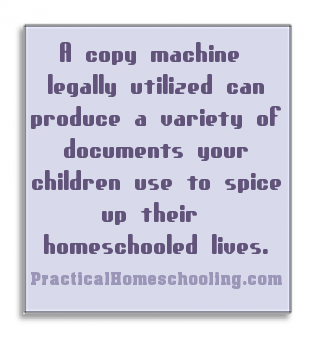Photocopying Ideas
By Kathy von Duyke
Printed in Practical Homeschooling #3, 1993.
 Kathy von Duyke has new ideas about how to use the copier (legally) for everything from household management to science.
Kathy von Duyke has new ideas about how to use the copier (legally) for everything from household management to science.

|
 |
 When I began homeschooling, I thought visiting the copy store would be easy. That idea was blown quickly! Imagine trying to copy 70 pages of a reproducible workbook, lugging a baby in one arm, and keeping an eye on a toddler attempting to disappear out the door. I next tried to hit the copy store late at night, sans kids. That's when the college students take over -- I braved Led Zepplin while copying my little Bible worksheets and thanked the person behind the counter wearing multiple earrings, dyed hair, and a skirt for his time. My next option was to send my husband off with a stack of things to copy. This worked for me, but bogged him down.
When I began homeschooling, I thought visiting the copy store would be easy. That idea was blown quickly! Imagine trying to copy 70 pages of a reproducible workbook, lugging a baby in one arm, and keeping an eye on a toddler attempting to disappear out the door. I next tried to hit the copy store late at night, sans kids. That's when the college students take over -- I braved Led Zepplin while copying my little Bible worksheets and thanked the person behind the counter wearing multiple earrings, dyed hair, and a skirt for his time. My next option was to send my husband off with a stack of things to copy. This worked for me, but bogged him down.
I eventually figured out that the copy store people would copy for me if I dropped the work off, either for free or a small fee. This was definitely worth it! Later when my children got old enough to help copy, they did much of it, and later I must confess, we got our own copy machine (this is akin to admitting we have a rich relative who died, or a maid who comes in weekly).
Having a copy machine has allowed me to explore and use it in new ways. In the old days I copied every page of a reproducible workbook. I didn't want to get stuck running out. Consequently, we have a paper trail of our homeschooling that would please any court system within a stack of papers marked "to color" for my toddlers. Now, I only copy one month's worth of work at a time. Even if I still had to go out to copy, I would do no more than that. I am overeager with a new school year and will always copy too much.
Here are some ways to make the copy machine work for you:
Household Management
Household Recipe Book. Copy your favorite recipes and put them all in one notebook. (It is fair use to copy a recipe or two out of a library book, but if you were going to use a bunch of them, you ought to buy the book.) Include your favorite clay recipe, paste, and paints as well. Slip everything in clear report cover sheets for extra hard duty.
Game Book. Copy all the directions to your games and file in a notebook, get rid of the boxes, and store all the game guts in a drawer.
Labels. When sending a family newsletter, make use of Avery copier labels. Simply type a page of addresses, then copy as many labels as you need. Having family address labels on file makes it easier to remember to write and send letters. Stick labels with your address on them on items you might loan out, such as books, videos, tapes, and disks.
Homeschool Management
Library Record. Now that most libraries have gone to computerized systems, there are no longer cards to remove and store. No quick way to figure out which books are missing when you go back! Before leaving the library, stack the books and photocopy the bindings so you have a record of the books you borrowed. (Then just have the children date and initial each book they read right on the photocopy. Instant school records of what they read! -- Mary)
Lesson Plans. Make a lesson plan template for each month. Make a copy of this template, then fill in your child's workbook names. You may change you mind later about a workbook so don't put it on your blank template! Next, copy this filled template and add in assigned pages or activities for one month. Make a copy for each child to use as assignments, and one for your records. I keep these on a clipboard. I add to these teaching instructions I'm using various books that week. This way I keep handy all the notes I need and a reference on what each child is doing. I don't shuffle and search through a variety of books for teaching notes or chase my children's assignment sheets down. Important, since I'm a one-armed, i.e., nursing mother!
Homeschool Activities
Quick Toddler Activity. Photocopy a few objects; a spoon, a pencil, a paper clip, etc. Let your child match the objects to the paper. You'll need to throw a coat over the machine to block the light since you can't close the cover adequately on 3-D objects.
Blank Game Format. Make up some basic blank game formats such as bingo, lotto, concentration, go fish, matching, or games where you roll dice and follow the squares. Photocopy or have your store copy these onto card stock. You can quickly produce a game format for drilling you child. An older sibling can challenge their own understanding of a topic while developing a game for a younger child.
Social Studies Activities. If you own a set of encyclopedias, you can make the information much more accessible in your homeschool. Use it as a source for pictures, lists, and timelines, as well as information. You can quickly translate these sources into your own worksheets, mini-posters and hands-on activities. Copy a list of events and faces of people relative to those events and post it in the kitchen, above a bed, or in a bathroom.
If you own a Geosafari board you can make your own quiz game. Children can match faces to faces, faces to names, or arrange them sequentially through time.
You can copy a list of events, steps of production, or poetry and, after cutting it apart, have your child try to sort or arrange the material. For instance, have your child sort pictures into piles for the Civil and Revolutionary wars. A toddler could match Robert E. Lee to Robert E. Lee while a five-year-old decides which war Lee belongs in and a ten-year-old decides which of several faces fought against Lee and which with him.
Language Arts. Have you ever had the frustration of typing out a child's story and when he tried to illustrate it he "messed up?" Copy several pages of your typed work so if your children "mess up" they can start again. You can also feed the art work right into the machine as your blank paper, then copy the typed words right onto the art. No cut-and-paste look to the finished product.
The copy machine can help your child rewrite papers without all the hand cramping and drudge work. Children need to see writing as fluid, with room for reworking. Photocopy a paper and have them cut it up and rearrange paragraphs, insert new information, or sort sentences into like categories.
A more profound and direct approach to studying language structure comes, not with working fill-in-the-blank style, but directly with a passage the way an author does. Follow Ruth Beechick's principles in You Can Teach Successfully. Copy a section of great literature, i.e., Little House on the Prairie, the Bible, or Shakespeare. Have your child mark the passage for nouns, verbs, direct objects, note the use of commas and semicolons, and color short and long sentences differently to see length variation. Have the children cut a passage apart and rearrange it to gain insight into the author's style. Copy a table of contents and have the child briefly fill in or narrate a capsule statement of each chapter.
Science. Here's a surprising use. The copy machine makes startling reproductions of plants! Collect local plant samples. Using identification books, you can then create a field guide to your own yard. Color the copies, categorize and sort them, then put them into a booklet or report. Make an A to Z book for preschoolers. Pressed plants are fragile, but the reproductions hold up to hard use.
Experiment with insects, shells, crystals, and even animal parts. Okay, I confess, your local copy store may be a bit discomfited if you bring in fetal pig guts to copy. Discretion is advised. Children can label parts and color in the photocopy they have made from their own samples. This is a more significant experience for them than simply labeling worksheets.
Arts and Crafts. Copy machines are great for enlarging or reducing patterns to fit that spot or size just right. Construction paper can be threaded through the machine to copy a pattern for cutting or pasting, crafts or book covers. If you switch to a transparency sheet, you can copy a pattern onto the sheet, then color it in with permanent markers. Mounted in a window, this gives a stained glass effect. Dover books carry beautiful stain glass designs, making this an activity appropriate for ages toddler to adult.
Remember, too, that your copy store has oversized machines, often used for blueprints or large family trees and documents. The larger size could be useful for patterns, charts, or your own posters.
Copy Legally
Finally, pay attention to copyright laws. To violate these would deny the author or illustrator a fair wage for his work. Generally, it is acceptable to copy reproducible workbooks for use with your own "classroom," e.g., your own children. If the workbook you are considering copying is not labeled "reproducible" or "black line masters," it is not legal to copy it. Your choice in this situation is to buy copies of the workbook for each student, or to use the workbook like a textbook and write answers to the exercises on separate paper.
You can copy small portions of library books for the purpose of research. (Rule of thumb: if it is too long an extract to copy by hand without getting finger cramps, it's too long for "fair use" copying by machine.) You can copy books you own, for your own use only, in order to make the copied portions easier to handle -- for example, to punch and add to a three-ring-binder full of information you are collecting on a particular topic. If you want to copy part of a library book for larger classes, contact the publisher. They will usually give permission, or charge a small usage fee.